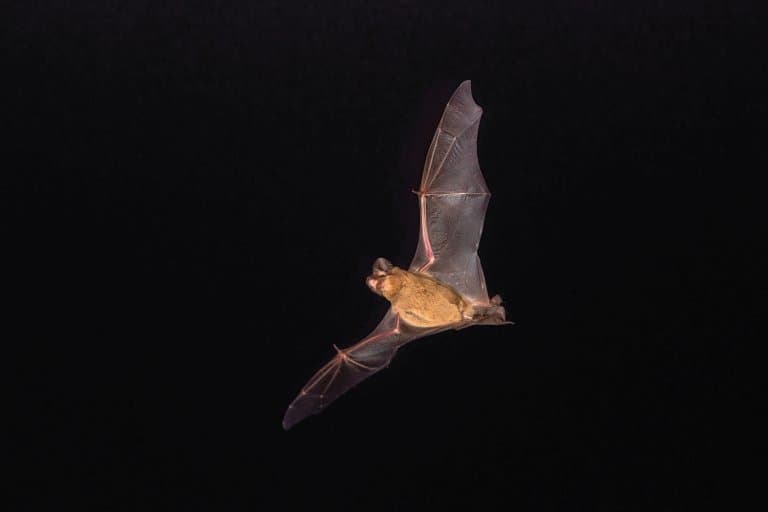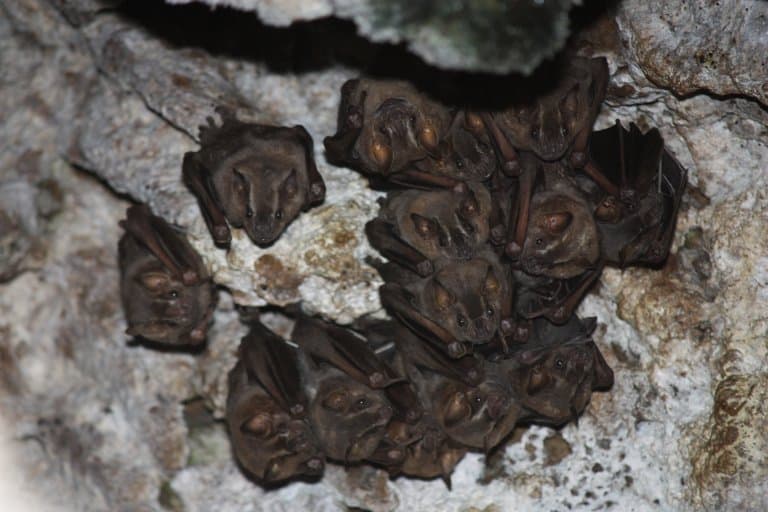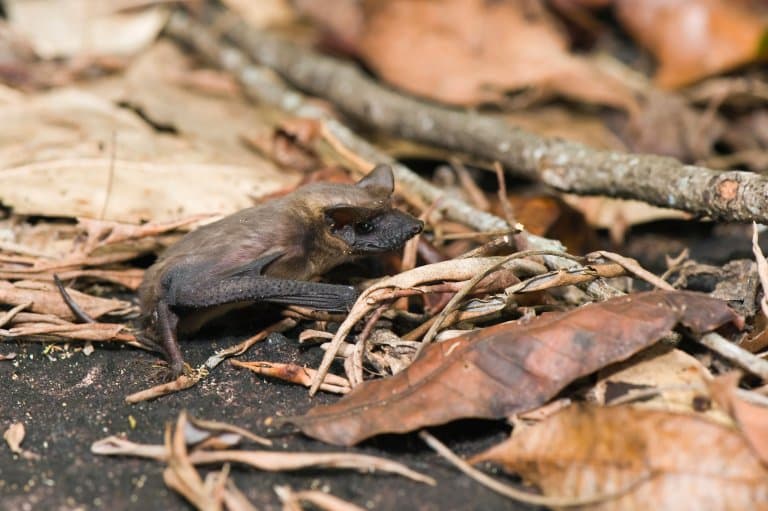Mexican Free-Tailed Bat Profile
The Mexican free-tailed bat, also called the Brazilian free-tailed bat, is a fast-flying, small bat found across North, Central and South America.
Unlike most other bat species, they belong to a family of bats known for their free-hanging tails which extend past their lower wing membrane.
Like other free-tailed bats, the Mexican free-tailed bat is also an excellent flier, capable of flying at much higher heights than most other types of bat. They are also extremely fast, and and broken the record for the fastest verified flying speed in level flight of any animal.

Mexican Free-Tailed Bat Facts Overview
| Habitat: | Caves and made-made buildings |
| Location: | North, Central and South America |
| Lifespan: | 8 years in the wild |
| Size: | Body length 85mm. Tail length 40mm. Wingspan 280mm |
| Weight: | 7 – 12 grams |
| Color: | Small brown bat with short, wrinkled face and large ears. Tail hangs freely behind body |
| Diet: | Insectivorous |
| Predators: | Raptors, snakes and small carnivorous mammals |
| Top Speed: | 160 kph (100 mph) |
| No. of Species: |
1 |
| Conservation Status: |
Least Concern |
These curious bats are highly adaptable and therefore are found through the Americas. They prefer to roost in large, dark caves, but are also commonly found in large buildings, under bridges and even highway underpasses.
The Mexican free-tailed bat is a sociable mammal, often found in colonies consisting of hundreds of thousands of individuals or more. They are strictly nocturnal, leaving the roost after sunset in search of their insect prey.
Like all insect-eating bats, the Mexican free-tailed bat captures prey through echolocation. By producing high frequency sounds, these pulses bounce off objects and the echo allows the bat to distinguish what that object is. This allows them to capture small insects which themselves are capable of flying at relatively fast speeds. Mexican free-tailed bats will feed on most flying insects, especially moths, flies, beetles and dragonflies.
Though they are excellent hunters themselves, Mexican free-tailed bats are also predated on by many other predators. Roosting in huge colonies can make individuals easy prey for snakes, skunks, raccoons and opossums. When in flight they are at their most vulnerable upon leaving their roost, where owls, kites and hawks swoop down upon the masses of bats in hope of catching the weaker or more unsuspecting individuals.
Mexican free-tailed bats, though found in huge numbers, produce only a single pup each year. After around 3 months, the pup is born upside down and has to find its own way to its mother’s milk. After the first feed however, the pups are left in a large group, known as a crèche. Here the young bats huddle together to keep warm while their mothers are out hunting. In order to locate their young amongst all the other pups on their return, female Mexican free-tailed bats are able to identify both the individual call and scent of their offspring.
As is the case with most bats, Mexican free-tailed bats play a crucial role in the ecosystem.
Due to their large numbers, colonies are able to consume huge amounts of insects in a single night. Many of the insects they eat are known as crop pests and the bats presence in an area actively benefits farmers through keeping pest numbers down.
Interesting Mexican Free-Tailed Bat Facts
1. They are the fastest flying animals in the world
Of all their interesting traits, the flying ability of the Mexican free-tailed bat is perhaps the most astonishing. For such a small animal, they are able to reach heights and speeds that few other bats (and even some birds) are able to attain.
In 2016, researchers recorded an individual bat rocketing out of its nesting area at 160 kmph during periods of low to no wind. This makes the mexican-free tailed bat the fastest flying animal in level flight, let alone bat species.
They can also fly at heights over 10,000 feet, which also makes them the highest flying bat species in the world. 1

2. Their colonies can consist of millions of bats
Although colonies can consist of any number of individuals, where roosting sites are large enough, their colonies can contain millions of bats.
The largest colony ever recorded, at Bracken Cave in San Antonio, was made up of around an unbelievable 20 million bats! As well as using roost sites to breed and rest, Mexican free-tailed bats spend a large proportion of time interacting with one another after foraging.
When awake, they squeak, call and touch one another to reaffirm their group bonds.
3. They prefer dark places with large ceiling space for roosting
These bats prefer caves and disused mines to roost in but can be found in attics, barns and even under bridges.
4. The Mexican free-tailed bat is a tourist attraction
Due to their immense numbers, tourists will often flock to cave entrances to observe the extraordinary spectacle of millions of bats leaving their roosts.
Tourists flock to both Congress Avenue Bridge in Austin, Texas, or at Bracken Cave in San Antonio to witness their displays. It’s estimated 100,000 bat tourists visit each year and bring in over $10m in revenue in Austin.
5. They are small bats
About the size of two adult thumbs put together, these tiny mammals weigh less than 2 teaspoons of sugar. 2
6. They can eat 250 tonnes of insects in a single night
Large colonies of Mexican free-tailed bats are capable of eating over 250 tonnes of insects in a single night, which helps keep insect populations under control saving farmers millions of dollars in the process.
As well as crop pests, these bats also feed heavily on disease-carrying insects such as flies, mosquitoes and biting midges.3
7. Bat pups reach independence very quickly
Just 5 weeks after being born, young Mexican free-tailed bats become fully independent from their mothers.
8. They prefer to roost near water
As well as providing a source of drinking water in drier areas, water bodies also attract insects which means roosts near lakes and rivers are highly sought after.

9. Mexican free-tailed bats do not tolerate extremely cold weather
These bats do not truly hibernate but can reach a state of torpor. If the weather remains extremely cold for too long, many bats in the colony will die.
10. In some areas they can travel long distances in search of food
As they are such strong fliers, Mexican free-tailed bats have been known to travel over 50km in search of good hunting grounds.
11. They will migrate to warmer areas in the winter
In colder seasons, colonies may fly large distances to reach their summer roosts to avoid cold temperatures. 4
12. Their excrement is an excellent fertiliser
Known as guano, the faeces of the Mexican free-tailed bat is sometimes collected and used as a natural fertiliser for plants.

13. Their population is declining
While they are widespread, one of the most abundant mammals in North America and considered of least concern by the IUCN, there is concern for their future.
Due to the way they roost in huge numbers, but relatively few locations, they are vulnerable to habitat destruction. In 2006, the Mexican environmental conservation purchased a cave near Monterrey, Mexico and placed it under conservation due to the bat population dropping from 20m to 600k. This was as a result of uncontrolled tourism, pollution, vandalism and neglect.
They are also considered a special concern in California due to declining populations, and Bracken Cave was purchased by Bat Conservation International from private ownership.
Mexican Free-Tailed Bat Fact-File Summary
Scientific Classification
| Kingdom: | Animalia |
| Phylum: | Chordata |
| Class: | Mammalia |
| Order: | Chiroptera |
| Family: | Molossidae |
| Genus: | Tadarida |
| Species Name: |
Tadarida Brasiliensis |
Fact Sources & References
- Gary F. McCracken (2016), “Airplane tracking documents the fastest flight speeds recorded for bats“, The Royal Society.
- “Mexican free-tailed bat (Tadarida brasiliensis)“, Bat Conservation International.
- “Mexican Free-tailed Bat“, Nevada Department of Wildlife.
- Hugh H. Genoways (2000), “Extralimital Records of the Mexican Free-Tailed Bat (Tadarida brasiliensis mexicana) in the Central United States and their Biological Significance“, ResearchGate.
